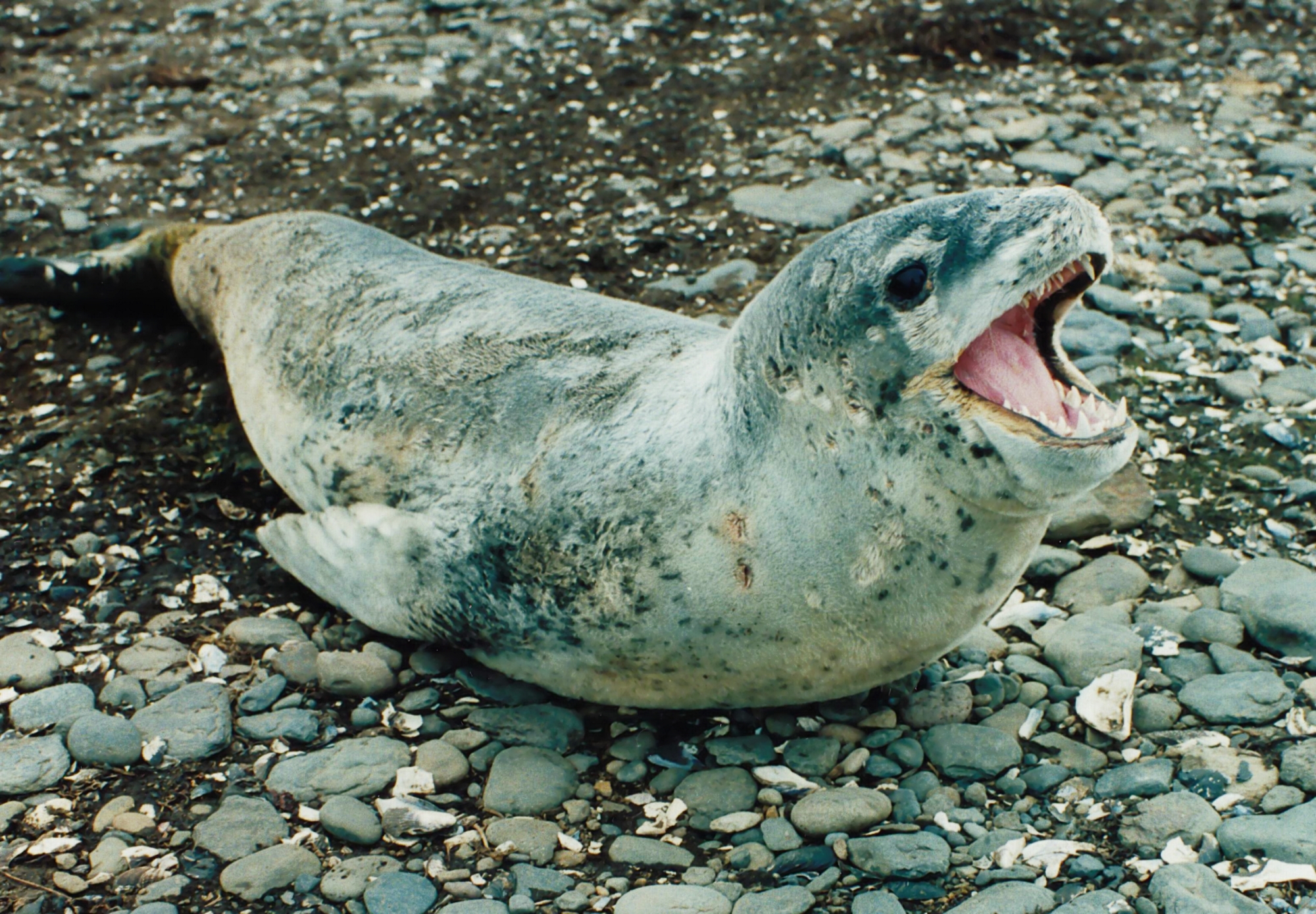Post by Infinity Blade on Mar 28, 2015 5:33:55 GMT 5
Leopard Seal-Hydrurga leptonyx

Temporal range: Holocene
Scientific classification:
Kingdom: Animalia
Phylum: Chordata
Infraphylum: Gnathostomata
Clade: Eugnathostomata
Clade: Teleostomi
Clade: Tetrapoda
Clade: Reptiliomorpha
Clade: Amniota
Clade: Synapsida
Order: Therapsida
Clade: Theriodontia
Clade: Eutheriodonta
Suborder: Cynodontia
Clade: Epicynodontia
Infraorder: Eucynodontia
Parvorder: Probainognathia
Superfamily: Chiniquodontoidea
Clade: Prozostrodontia
Clade: Mammaliaformes
Class: Mammalia
(unranked): Pegasoferae
(unranked): Zooamata
Clade: Holotheria
Superlegion: Trechnotheria
Legion: Cladotheria
Sublegion: Zatheria
Infralegion: Tribosphenida
Subclass: Theria
Clade: Eutheria
Infraclass: Placentalia
Subcohort: Exafroplacentalia
Magnorder: Boreoeutheria
Superorder: Laurasiatheria
(unranked): Ferae
(unranked): Carnivoramorpha
Order: Carnivora
Suborder: Caniformia
Infraorder: Arctoidea
Clade: Pinnipedia
Superfamily: Phocoidea
Family: Phocidae
Subfamily: Monachinae
Tribe: Lobodontini
Genus: Hydrurga
Species: H. leptonyx
The leopard seal is a species of seal that lives in Antarctica. It's one of the largest seals living in its respective continent. Its name comes from the spots on its coat (reminiscent of a leopard). The coat has a dark grey dorsal color and a silvery grey ventral color. It possesses a long, slender body allowing for great agility in the water[1] and a head that can be described as 'quasi-reptilian' (Darren Naish even describing it as having a "theropod-like jawline and robust skull demarcated from its neck"[2]). The foreflippers are used in aquatic locomotion, unlike in other seals that use their hindlimbs.[3] Males are ~3 meters long and ~300 kilograms in weight while females are ~3.8 meters long and ~500 kilograms in weight.[1] Apparently, they can reach ~591 kilograms.[3] The canines and incisors are raptorial and excellent for predation on vertebrate prey. By contrast, the molars are used to sieve krill from water. Supposedly, krill constitute ~45% of their diet, other seals (namely crabeater seals) ~30%, penguins ~10%, and fish and cephalopods ~10%, although this can vary. Leopard seals themselves are preyed upon by orcas. Males reach sexual maturity after 6 to 7 years while females do so after 3 to 4 years. Gestation lasts 11 months. A single ~30 kilogram, ~1.6 meter pup is born. Leopard seals can live for approximately 26 years.[3]
References:
[1] animaldiversity.org/site/accounts/information/Hydrurga_leptonyx.html
[2] darrennaish.blogspot.com/2006/02/swan-necked-seals.html
[3] marinebio.org/species.asp?id=160

Temporal range: Holocene
Scientific classification:
Kingdom: Animalia
Phylum: Chordata
Infraphylum: Gnathostomata
Clade: Eugnathostomata
Clade: Teleostomi
Clade: Tetrapoda
Clade: Reptiliomorpha
Clade: Amniota
Clade: Synapsida
Order: Therapsida
Clade: Theriodontia
Clade: Eutheriodonta
Suborder: Cynodontia
Clade: Epicynodontia
Infraorder: Eucynodontia
Parvorder: Probainognathia
Superfamily: Chiniquodontoidea
Clade: Prozostrodontia
Clade: Mammaliaformes
Class: Mammalia
(unranked): Pegasoferae
(unranked): Zooamata
Clade: Holotheria
Superlegion: Trechnotheria
Legion: Cladotheria
Sublegion: Zatheria
Infralegion: Tribosphenida
Subclass: Theria
Clade: Eutheria
Infraclass: Placentalia
Subcohort: Exafroplacentalia
Magnorder: Boreoeutheria
Superorder: Laurasiatheria
(unranked): Ferae
(unranked): Carnivoramorpha
Order: Carnivora
Suborder: Caniformia
Infraorder: Arctoidea
Clade: Pinnipedia
Superfamily: Phocoidea
Family: Phocidae
Subfamily: Monachinae
Tribe: Lobodontini
Genus: Hydrurga
Species: H. leptonyx
The leopard seal is a species of seal that lives in Antarctica. It's one of the largest seals living in its respective continent. Its name comes from the spots on its coat (reminiscent of a leopard). The coat has a dark grey dorsal color and a silvery grey ventral color. It possesses a long, slender body allowing for great agility in the water[1] and a head that can be described as 'quasi-reptilian' (Darren Naish even describing it as having a "theropod-like jawline and robust skull demarcated from its neck"[2]). The foreflippers are used in aquatic locomotion, unlike in other seals that use their hindlimbs.[3] Males are ~3 meters long and ~300 kilograms in weight while females are ~3.8 meters long and ~500 kilograms in weight.[1] Apparently, they can reach ~591 kilograms.[3] The canines and incisors are raptorial and excellent for predation on vertebrate prey. By contrast, the molars are used to sieve krill from water. Supposedly, krill constitute ~45% of their diet, other seals (namely crabeater seals) ~30%, penguins ~10%, and fish and cephalopods ~10%, although this can vary. Leopard seals themselves are preyed upon by orcas. Males reach sexual maturity after 6 to 7 years while females do so after 3 to 4 years. Gestation lasts 11 months. A single ~30 kilogram, ~1.6 meter pup is born. Leopard seals can live for approximately 26 years.[3]
References:
[1] animaldiversity.org/site/accounts/information/Hydrurga_leptonyx.html
[2] darrennaish.blogspot.com/2006/02/swan-necked-seals.html
[3] marinebio.org/species.asp?id=160



